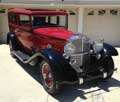|
Re: 1928 Front End Shimmy
|
||||
|---|---|---|---|---|
|
Home away from home

|
Who’s tires are they and are they new?
Posted on: 2021/7/3 20:58
|
|||
|
||||
|
Re: 1928 Front End Shimmy
|
||||
|---|---|---|---|---|
|
Home away from home
|
Tires are six years old and were balanced when they were 1st installed. Approx 1,000 miles have been put on these tires.
Balancing is relatively inexpensive and I am sure won't hurt have it done. I will check out some truck tire balancing stores... Thanks
Posted on: 2021/7/4 13:16
|
|||
|
||||
|
Re: 1928 Front End Shimmy
|
||||
|---|---|---|---|---|
|
Home away from home

|
Thanks - I should have mentioned in my post that it is not uncommon with new tires that are odd ball sizes like those you find on classics for them to be out out of round. I have two friends that bought Coker tires that were bad. To make matters worse, they would not stand behind them.
Posted on: 2021/7/4 14:17
|
|||
|
||||
|
Re: 1928 Front End Shimmy
|
||||
|---|---|---|---|---|
|
Forum Ambassador

|
Paralleling Peter Packard's experience,a tendency to shimmy with my 1934 Eight, especially when crossing obstacles at a diagonal, was solved by having a local truck shop dynamically balance the wire spoke wheels, tires with tubes, and brake drums as a unit assembly.
Posted on: 2021/7/4 14:41
|
|||
|
||||
|
Re: 1928 Front End Shimmy
|
||||
|---|---|---|---|---|
|
Not too shy to talk
|
Front end shimmy can be caused by several different things, several that have been mentioned. You may try swapping front and rear wheels to see a change. another place to look would be at the caster on your axle which I would expect to be be 2-3 degrees positive. Positive caster is what causes your wheels to come back to center when you turn. If you don't have enough positive caster when you steer back to center your wheels will easily go beyond center then back and forth trying to find that center. You may have to slow almost to a stop to stop the shimmy. You can put several hundred pounds in the rear of the car lowering the rear which increases the positive caster slightly. Easy test, no cost, no wrenches.
Dick
Posted on: 2021/7/5 19:49
|
|||
|
||||
|
Re: 1928 Front End Shimmy
|
||||
|---|---|---|---|---|
|
Not too shy to talk
|
Another suspect I didn't mention in my previous post is toe-in you should have about an eight inch of toe in measured at the rim, be sure to check for rim run out before measure. Again simple enough, a tape measure and a few minutes.
Dick
Posted on: 2021/7/7 19:20
|
|||
|
||||
|
Re: 1928 Front End Shimmy
|
||||
|---|---|---|---|---|
|
Home away from home
|
I had the front end alignment checked and it passed with flying colors. (Everything is within the specs, per the service manual:toe-in 1/8", Castor 1 deg, Camber 1 1/2"). I tried weight in the back of the car (150lbs) to no affect.
I was told by a mechanic tonight (car show) that the tire might be starting to fail from the inside or similar to what some other folks have suggested that the tire(s) may be out of balance. POA: move the back tires to the front. if shimmy still exists, try balancing tires. Suggestions are always appreciated. Thanks, Gar
Posted on: 2021/7/22 20:09
|
|||
|
||||
|
Re: 1928 Front End Shimmy
|
||||
|---|---|---|---|---|
|
Home away from home
|
Good Evening...At what speed does the shimmy begin? And under what conditions>? This information may help one of us to figure out the problem. I note that one of the early posters on this thread installed a modern horiontal shock absorber syestem and reports no more problems...I have one on my Model A Ford of the same vintage and it worked there as well. I note that my new Jeep has one as weill...These cars do have their mysteries...Prehaps even a few ghost drivers, trying to help you out!
Ernie in Arizona
Posted on: 2021/7/22 20:41
|
|||
|
Caretaker of the 1949-288 Deluxe Touring Sedan
'Miss Prudence' and the 1931 Model A Ford Tudor 'Miss Princess' 
|
||||
|
||||
|
Re: 1928 Front End Shimmy
|
||||
|---|---|---|---|---|
|
Home away from home

|
I have had shimmy while crossing train tracks at slow speed and I have had it at 40 mph rounding a curve and hitting a bump. Speed was not the trigger. All of the possible causes discussed here had been eliminated. It happened on both a 1922 Packard and a 1929, I suspect that the very large heavy wheels are a factor even though they had been balanced but I never found a definite cause and it rarely happened.
Posted on: 2021/7/23 7:39
|
|||
|
||||








